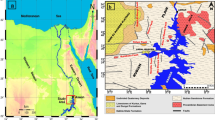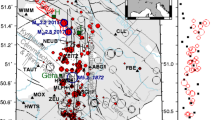Abstract
Three felt earthquakes with moderate local magnitudes range from 3.7 to 4.5 Richter are located southeast Luxor, south Egypt. The investigated events represents the largest instrumental earthquake to be recorded during the period from 1997 to 2024 in the southeast Luxor seismic zone, south Egypt. The most recent earthquake of January 2024 with local magnitude 4.5 was felt in various cities located close to and around the epicentral region such as Luxor, New Tiba, New Luxor, Armant, Esna, and Aswan areas. Full waveform moment tensor inversion is used to dedicate the fault planes orientation of the investigated earthquakes. The optimum source parameters accompanied with maximum fitting and the best double couple mechanism of the investigated events indicated that strike slip movement are dominated. The estimated values of the moment magnitude and seismic moment of December 2015, December 2022, and January 2023, are: 3.7, 1.43e + 21 dyne-cm; 3.3, 1.20e + 21 dyne-cm; and 4.4, 3.31e + 22 dyne-cm, respectively. The stochastic simulation method depending on the site spectral model is used to estimate the effect and strong ground motions parameters of the largest earthquake in January 2024 at the new planned constructed cities including New Luxor city and New Tiba city. The modulated parameters are represents as the peaks value of ground acceleration (PGA), ground velocity (PGV), ground displacement (PGD), and the pseudo spectral acceleration (PSA). The derived results revealed that the PGA (8.6 cm/s2), the PGV (0.22 cm/s), and the PGD (0.02 cm) simulated at New Luxor city with epicentral distance 38 km, while the modulated strong ground motion parameters at New Tiba city with epicentral distance 40 km are PGA (7.3 cm/s2), PGV (0.18 cm/s), and PGD (0.02 cm). The highest values of PSA are (24.82 cm/s2), and (21.23 cm/s2) at New Luxor and New Tiba cities are obtained, respectively. Although, the investigated events are moderate, they generate great interest for earthquake hazard along this active zone.









Similar content being viewed by others
Data availability
The data that support the findings of this study are available from NRIAG but restrictions apply to the availability of these data, which were used under license for the current study, and so are not publicly available. Data are however available from the authors upon reasonable request and with permission of NRIAG.
References
Abd El–Aal AEAK, Abdelhafiez HE, Saadalla H, Soliman MS (2020) A homogenous moment magnitude and local magnitude scaling relation for earthquakes in Egypt. NRIAG J Astron Geophys 9(1):532–538
Abdel Razik TM, Razvaliaev AV (1972) On the tec-tonic origin of the Nile Valley between Edfu and Qena Egypt. J Geol 16(2):235–245
Atkinson GM, Boore DM (1995) Ground motion relations for eastern North America. Bull Seism Soc Am 85:17–30
Badawy A (1999) Historical seismicity of Egypt. Acta Geod Geoph Hung 34(1–2):119–135
Badawy A (2005) Present-day seismicity, stress field and crustal deformation of Egypt. J Seismolog 9:267–276
Badawy A, Abdel-Monem SM, Sakr K, Ali SM (2006) Seismicity and kinematic evolution of middle Egypt. J Geodyn 42(1–3):28–37
Boore DM (1983) Stochastic simulation of high-frequency ground motions based on seismological models of the radiated spectra. Bull Seismol Soc Am 73(6A):1865–1894
Boore DM (2003) Simulation of ground motion using the stochastic method. Pure Appl Geophys 160:635–676
Brune JN (1970) Tectonic stress and the spectra of seismic shear waves from earthquakes. J Geophys Res 75(26):4997–5009
Egyptian Geological Survey and Mining Authority “EGSMA” (1981). Geologic Map of Egypt 1:2000000
Ezz El Deen M, El Sayed A, Barseem M (2014) The impact of subsurface geological structure on the groundwater occurrence using geophysical techniques in Wadi El Kallabiyyah and Wadi as Sabil, East Esna, Eastern Desert Egypt. Arab J Geosci 7(6):2151–2163
Hanks TC (1982) Fmax Bull Seism Soc Am 72:1867–1879
Herrmann RB (2013) Computer programs in seismology: An evolving tool for instruction and research. Seismol Res Lett 84(6):1081–1088
Herrmann RB, Wang CY (1985) A comparison of synthetic seismograms. Bull Seismol Soc Am 75(1):41–56
El Hosary M (1994) Hydrogeological and hydrochemical studies on Luxor area, southern Egypt. B. Sc. thesis, Faulty of Science
Kanai K (1983) Engineering seismology. University of Tokyo Press, Tokyo
Kamel ER (2004) Geology of Luxor area and its relationship to groundwater uprising under the Pharaohs Temples. Thesis, Aswan Faculty of Science, South Valley University, Egypt, M. Sc
Kebeasy RM (1990) “Seismicity” in Geology of Egypt (R. Said, Ed.) A.A. Balkerma, Rotterdam 1990:51–59
Khalil AE, El-Hady SM, Hosny A (2004) Three-dimensional velocity structure of VP and VP/VS around Aswan area Egypt. J Appl Geophys 3(1):303–314
Klitzsch E, Wycisk P (1987) Geology of the sedimentary basins of Northern Sudan and bordering areas. Berl Geowiss AbhA 75(1):97–136
Mohamed HH, Hassib GH, Dahy SA, El-Amin EM (2008) A review of the recent seismic activity in the southern part of Egypt (Upper Egypt). Acta Geodyn Geomater 5(1):149
Mohamed A, Ali SM, Mostafa A (2020) Estimation of seismic site effect at the new Tiba City proposed extension, Luxor. Egypt NRIAG J Astron Geophys 9(1):499–511
Mohamed A, Dosoky W, Abbas MA (2021) Site Effect Estimation Using Microtremor Measurements at New Luxor City Proposed Site, South Egypt. J Geosci Environ Protect 9(9):131–149
Omran AA, Riad S, Philobbos ER, Othman B (2001) Subsurface structures and sedimentary basins in the Nile Valley area as interpreted from gravity data. Egypt J Geol 45(1):681–712
Said R (1962) The geology of Egypt: Elsevier Sci. Pub. Co., Amsterdam, p 377
Said R (1990) The geology of Egypt: balkema. Rotterdam, Brookfield, p 734
Said R (2012) The geological evolution of the River Nile. Springer Science & Business Media
Sawires R, Ibrahim HA, Fat-Helbary RE, Peláez JA (2014) A seismological database for Egypt including updated seismic and focal mechanism catalogues. 8th Spanish-Portuguese assembly of geodesy and geophysics, Évora, Portugal, pp 29–31
Sawires R, Peláez JA, Fat-Helbary RE, Ibrahim HA, García-Hernández MT (2015a) An updated seismic source model for Egypt. Earthquake engineering—From engineering seismology to optimal seismic design of engineering structures 1–52
Sawires R, Peláez JA, Fat-Helbary RE, Ibrahim HA (2015b) An earthquake catalogue (2200 BC to 2013) for seismotectonic and seismic hazard assessment studies in Egypt. Earthquakes and their impact on society. Springer International Publishing, Cham, pp 97–136
Stump BW, Johnson LR (1977) The determination of source properties by the linear inversion of seismograms. Bull Seismol Soc Am 67(6):1489–1502
Zhang H, Eaton DW, Li G, Liu Y, Harrington RM (2016) Discriminating induced seismicity from natural earthquakes using moment tensors and source spectra. J Geophys Res: Solid Earth 121(2):972–993
Zoback ML (1992) First-and second-order patterns of stress in the lithosphere: The World Stress Map Project. J Geophys Res: Solid Earth 97(B8):11703–11728
Acknowledgements
We are grateful to the financial support from the Quarries Services Project working under the Seismology Department of NRIAG. We offer our profound thanks to the Aswan regional earthquake research center, and all the staff members of the Egyptian National Seismograph Network for their help and support. We thank the two anonymous referees for reviewing the manuscript and their constructive comments that significantly enhanced and improved the revised version of the manuscript.
Funding
Not applicable.
Author information
Authors and Affiliations
Contributions
HS processed the earthquakes data. The full moment tensor and simulation analysis performed by HS, and AK are involved in the interpretations and integration of the results. SI is involved in the final review and the response to the reviewer’s comments. All authors have read and approved the final manuscript.
Corresponding author
Ethics declarations
Ethics approval
Not applicable.
Consent for publication
Not applicable.
Competing interests
The authors declare that they have no competing interests.
Additional information
Publisher's Note
Springer Nature remains neutral with regard to jurisdictional claims in published maps and institutional affiliations.
Rights and permissions
Springer Nature or its licensor (e.g. a society or other partner) holds exclusive rights to this article under a publishing agreement with the author(s) or other rightsholder(s); author self-archiving of the accepted manuscript version of this article is solely governed by the terms of such publishing agreement and applicable law.
About this article
Cite this article
Saadalla, H., el-aal, A.ea.K.A. & Issawy, E. Source characterization and strong ground motion parameters modulation of the largest earthquakes southeast Luxor, south Egypt. Model. Earth Syst. Environ. (2024). https://doi.org/10.1007/s40808-024-02044-w
Received:
Accepted:
Published:
DOI: https://doi.org/10.1007/s40808-024-02044-w




